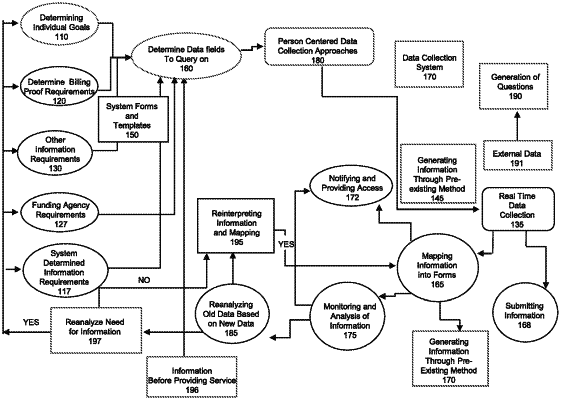| CPC G16H 10/60 (2018.01) [H04L 63/10 (2013.01)] | 13 Claims |

|
1. An improvement to the way that computer systems operate to provide HIPAA-compliant access of a user to electronic personal health information of an individual under care, the improvement comprising a HIPAA-compliant computer security method of recording visual personal health information in an electronic format relating to at least two individuals, at least one of whom is the individual under care, from a video camera, preventing unauthorized access of the user to the information, determining an action to satisfy an indicated need based on the information, and transmitting a signal for initiating that action, comprising:
storing records of physical attributes of the individual under care and the one or more individuals other than the individual under care;
recording electronic video signal personal health information, via a video camera, including physical attributes of the individuals;
transmitting at least a portion of said video information to a computer system with a memory and a processor;
storing, by said computer system, at least a portion of said transmitted video information;
storing, by said computer system, at least one authorization profile associated with the user, wherein the user is associated with one or more roles and one or more caseloads and the caseloads include access privilege information for the individual under care, wherein said user access privilege information included in said user's caseload includes the identities of individuals under care to which the user has access;
determining, by said computer system, whether said user is permitted to view said information pertaining to a caseload of the individual under care, wherein the determination is based on said authorization profile and the one or more caseloads and the one or more roles associated with the user, wherein said determining includes:
comparing the stored records, of physical attributes of the individual under care and the one or more individuals other than the individual under care, to the stored video information,
identifying a portion of said stored video information pertaining to the one or more individuals other than the individual under care by matching at least one of a face, eye color, and/or hair color in the stored records of physical attributes of an individual other than the individual under care with the face, eye color, and/or hair color of an individual other than the individual under care in the stored video information,
identifying a portion of said stored video information pertaining to the individual under care by matching at least one of a face, eye color, and/or hair color in the stored records of physical attributes of the individual under care with the face, eye color, and/or hair color of the individual under care in the stored video information; and
comparing the identity of the individual under care to the user's authorization profile information, including comparing the identity of the individual under care to the user's caseload, and granting access to the user to said portion of said stored video information pertaining to the individual under care if the identity of the individual under care is stored in the user's caseload; and
blurring, by said computer system, said portion of said stored video information pertaining to the one or more individuals other than the individual under care, wherein the entire image of the one or more individuals other than the individual under care is blurred, and wherein said blurring is done prior to any human viewing said stored video information;
transmitting, by said computer system, said portion of said stored video information pertaining to the individual under care, and said blurred portion of said stored video information pertaining to the one or more individuals other than the individual under care, to said caseload of said individual under care for HIPAA-compliant viewing by said user authorized to view said portion of said stored video information pertaining to the individual under care;
wherein at least a portion of said stored video information pertains to an initial inquiry relating to one or more goals of the individual under care;
storing, by said computer system, historical information, wherein said historical information pertains to said initial inquiry relating to said individual's care;
comparing, by said computer system, said historical information and at least a portion of said stored video information;
determining, by said computer system, an interpretation of said stored video information and said historical information;
determining, by said computer system, whether said interpretation indicates a need for action in the furtherance of said goal of the individual under care;
determining, by said computer system, based on said indicated need, an action to satisfy said need; and
transmitting, from said computer system, a signal for initiating said action to satisfy said need.
|